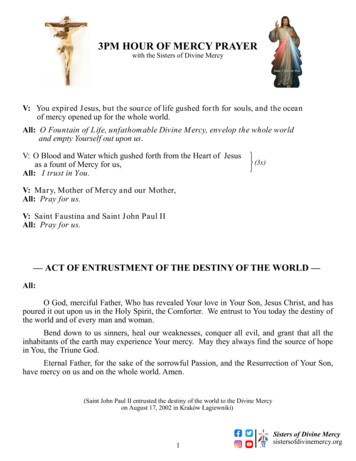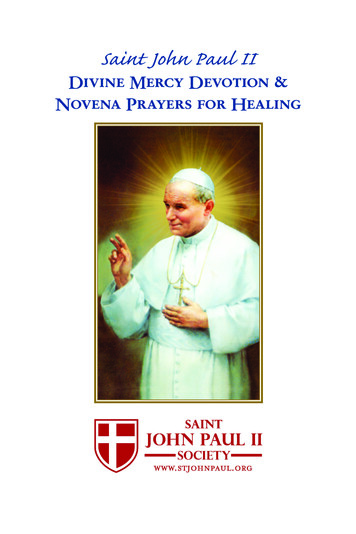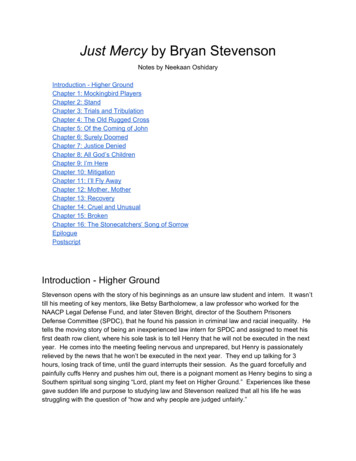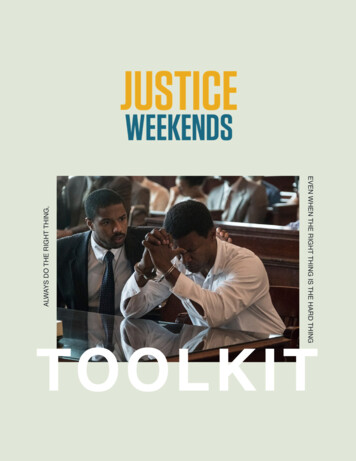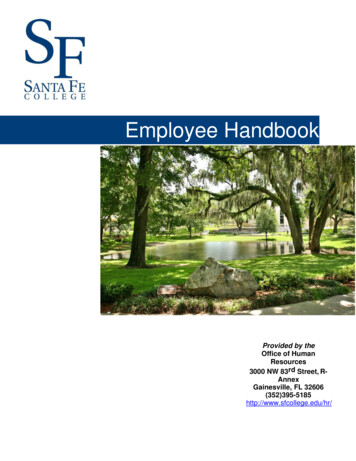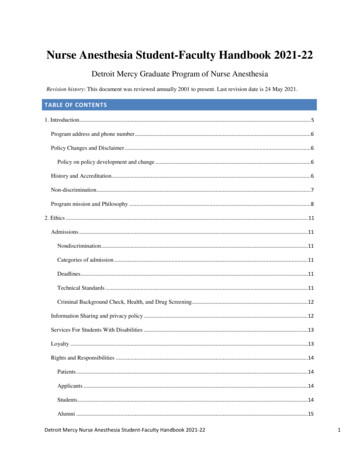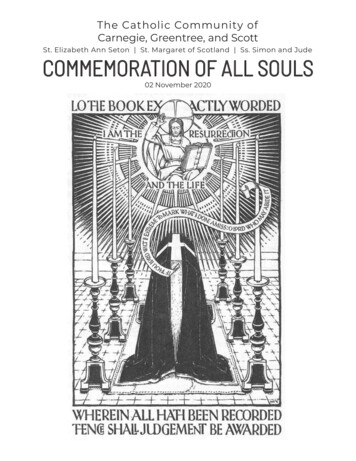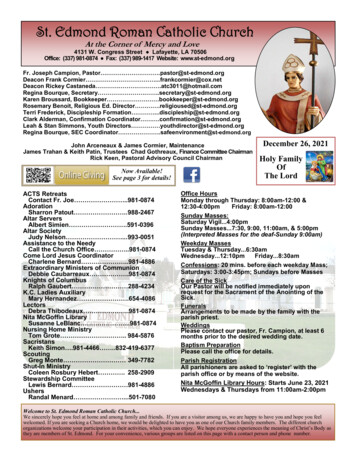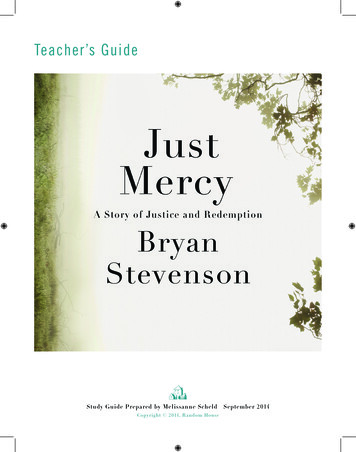
Transcription
Teacher’s GuideA Story of Justice and RedemptionBryanStevensonStudy Guide Prepared by Melissanne ScheldCopyright 2014, Random HouseSeptember 2014
A NOTE TO EDUCATORSThe following guide has been prepared in conjunction with the national Common Core Standards. Eachchapter contains summary points, discussion questions for the class and activities requiring various skillsand interpretation of the text. The following list of Standards correlates to the discussion questions as a wholewhereas, for each of the activities, the relevant and specific Standards are indicated for each of the exercises.English Language Arts: College and Career Readiness Anchor Standards for Reading: Key Ideas & Details:CCRA.R.1-R.3, Integrations of Knowledge and Ideas: CCRA.R.7, CCRA.R.8, Range of Reading and Level ofText Complexity: CCRA.R.10English Language Arts: College and Career Readiness Anchor Standards for Writing: Text Types andPurposes: CCRA.W.1-CCRA.W.3, Production and Distribution of Writing: CCRA.W.4, Research to Build andPresent Knowledge: CCRA.W.7-CCRA.W.9, Range of Writing: CCRA.W.10English Language Arts: College and Career Readiness Anchor Standards for Speaking and Listening:Comprehension and Collaboration: CCRA.SL.1-CCRA.SL.3, Presentation of Knowledge and Ideas: CCRA.L.4English Language Arts: College and Career Readiness Anchor Standards for Language: Conventions ofStandard English: CCRA.L.1, CCRA.L.2, CCRA.L.6, Vocabulary Acquisition and Use: CCRA.L.6English Language Arts: Reading: Literature: Key Ideas and Details: RL.11-12.1, RL.11-12.2, Integration ofKnowledge and Ideas: RL.11-12.7English Language Arts: Reading: Informational Text: Key Ideas and Details: RI.11-12.1-12.3, Integration ofKnowledge and Ideas: RI.11-12.7-12.8, Range of Reading and Level of Text Complexity: RI.11-12.10English Language Arts: Writing: Text Types and Purposes: W.11-12.1, 12.1.A, 12.1.B, 12.1.D, W.11-12.2,W.11-12.2.A, W.11-12.2.B, W.11-12.3, W.11-12.3.A, W.11-12.3.D, W.11-12.3.E, Production and Distribution ofWriting: W.11-12.4, Research to Build and Present Knowledge: W.11-12.7-12.9, W.11-12.9.BEnglish Language Arts: Speaking and Listening: Comprehension and Collaboration: SL.11-12.1-SL.11-12.3,Presentation of Knowledge and Ideas: SL.11-12.4, 12.6English Language Arts: Language: Conventions of Standard English: L.11-12.1, L.11-12.2, L.11- 12.2A, L.1112.2B, L.11-12.6English Language Arts: History/Social Studies: Key Ideas and Details: RH.11-12.1-RH.11.12.3, Craft andStructure: RH.11-12.6, Integration of Ideas: RH.11-12.9, Range of Reading and Level of Text Complexity:RH.11-12.102
PRE-READING ASSIGNMENTPrepare a two-page essay for a law school application explaining thereasons why you want to work with disadvantaged clients.INTRODUCTION: HIGHER GROUND In 1983 —twenty-three years old and in law school—Bryan Stevenson meetshis first death row client. From the 1970s to 2014, the U.S. prison population has increased from300,000 to 2,300,000; the highest incarceration rate in the world. One in every fifteen babies born in 2001 is predicted to spend time in jail.One in three black males born in this century is predicted to be incarcerated. The United States has sent a quarter of a million children to adult prisonsand jails, some are under the age of twelve. The number of women in prison has increased 640 percent in the lastthirty years. Spending on jails and prisons by state and federal governments has risenfrom 6.9 billion in 1980 to nearly 80 billion in 2014. Private prison builders and prison service companies have spent millionsof dollars to persuade state and local governments to create new crimes,impose harsher sentences, and keep more people locked up so that they canearn more profits. Through his work with the poor and the incarcerated, Stevenson concludesthat the opposite of poverty is not wealth; the opposite of poverty is justice.3
CHAPTER 1Mockingbird PlayersSUMMARY Stevenson is a member of the bar in both Georgia and Alabama. Despite receiving a warning phone call from the local Judge Robert E. Lee Key about WalterMcMillian’s case, Stevenson continues on. In Monroe County, Alabama, a beloved eighteen-year-old white woman named Ronda Morrisonis brutally murdered with very little evidence pointing toward a perpetrator. The police are undertremendous pressure to solve this mystery. Seemingly unrelated to Morrison’s murder, a poor woman named Vickie Lynn Pittman is alsomurdered. Karen Kelly, a white woman with a drug problem and a criminal record, is accused of themurder along with an accomplice, Ralph Myers. During an earlier child custody battle between Kelly and her husband, McMillian had previouslytestified to having a relationship with Kelly. McMillian quickly loses public respect and his businessloses many customers, particularly whites. The accomplice, Myers, is not a particularly trustworthy person, and as a way to lessen his sentence forthe Pittman murder, he claims to have witnessed Walter McMillian at the scene of the Morrison crime. There was no evidence against McMillian, but law enforcement targeted him because he was anAfrican American man involved in an adulterous interracial affair, which meant he was reckless andpossibly dangerous, even if he had no prior criminal history and a good reputation.DISCUSSION QUESTIONS1.How did Stevenson’s background prepare him for law school?2.In the introduction, he discusses his grandmother’s background and what impact that had on hiscareer choices. What from your own personal background has influenced your career choices?3.What famous novel was written in Monroe County, AL, and how is it relevant to Just Mercy?4.In what ways ‘Alabama’s economic policies disadvantage the state’s African American population?5.Why was Ralph Myers considered to be so trustworthy by the Monroe County police department?ACTIVITY4
1.Research incarceration rates for other wealthy nations; prepare a document that compares how longpeople serve for various crimes.2.Research Loving v. Virginia. What surprises you about this case? Do you think these issues are stillrelevant in our current times?CORRELATES TO COMMON CORE STANDARDSCollege and Career Readiness: Reading: Key Ideas and Details: CCRA.R.1-R.2, Integration of Knowledge andIdeas: CCRA.R.7, Range of Reading and Level of Text Complexity: CCRA.R.10College and Career Readiness: Writing: Text Types and Purposes: CCRA.W.1-W.3, Production andDistribution of Writing: CCRA.W.4, Research to Build and Present Knowledge: CCRA.W.7-W.9College and Career Readiness: Language: Conventions of Standard English: CCRA.L.1, CCRA.L.2,CCRA.L.6English Language Arts: Reading: Literature: Key Ideas and Details: RL.11-12.1, RL.11-12.2English Language Arts: Reading: Informational Text: Key Ideas and Details: RI.11-12.1-12.3, Integration ofKnowledge and Ideas: RI.11-12.8-12.9, Range of Reading and Level of Text Complexity: RI.11-12.10English Language Arts: Writing: Text Types and Purposes: W.11-12.1, 12.1.A, 12.1.B, 12.1.D, W.11-12.2,W.11-12.2.A, W.11-12.2.B, W.11-12.3, W.11-12.3.A, W.11-12.3.D, W.11-12.3.E, Production and Distribution ofWriting: W.11-12.4, Research to Build and Present Knowledge: W.11-12.7-12.9, W.11-12.9.BEnglish Language Arts: Language: Conventions of Standard English: L.11-12.1, L.11-12.2, L.11-12.2A, L.1112.2B, L.11-12.6English Language Arts: History/Social Studies: Key Ideas and Details: RH.11-12.1-RH.11.12.3, Craft andStructure: RH.11-12.6, Integration of Ideas: RH.11-12.9, Range of Reading and Level of Text Complexity:RH.11-12.105
CHAPTER 2StandSUMMARY Stevenson describes two cases in Gadsden, Alabama, where black men died at the hands of the police.Lourida Ruffin, thirty-nine, claimed that police had beaten him after he committed a minor trafficviolation and then refused to give him access to his asthma inhaler. He later died in his holding cell.Other prisoners witnessed the attack. While working on the Ruffin case, Stevenson learns of the death of a young black teenager who was pulledover by the Gadsden police. Upon reaching for his new license, the teenager was shot and killed by theofficer, who claimed that the deceased had been acting erratically. His parents described their son asnervous but also law-abiding and respectful. No evidence of a gun or other wrongdoing was discovered. Stevenson himself has a terrifying encounter with the Atlanta police while sitting in front of hisapartment, listening to music late at night. Several police surround him, one pointing a gun. While heis ultimately released without further incident, he is embarrassed, frightened, and angry that the policeviolated numerous laws while searching his car. He files a complaint which is largely ignored. Rather than waging a war with the bureaucracy of the Atlanta police force, Stevenson decides to workdirectly with those at the greatest risk—poor and young black men—by speaking directly to them atyouth groups, churches, and community organizations.DISCUSSION QUESTIONS1.Does your state have Stand Your Ground laws? Do you support them?2.Stevenson wished he had been more assertive with the police while they were illegally searching hiscar. Do you think that would have been effective? How would you recommend someone respond in asimilar situation?3.Do you think the police officers acted appropriately? How else might they have approached the situation?4.Likewise, did their supervisors respond fairly to Stevenson’s official complaint?5.How did the senior citizen attending Stevenson’s church lecture earn his “medals of honor”?6
XACTIVITYResearch response to police misconduct in the United States; based on your information determine what approachesare effective means of reducing police brutality and increasing accountability.CORRELATES TO COMMON CORE STANDARDSCollege and Career Readiness: Reading: Key Ideas and Details: CCRA.R.1-R.2, Integration of Knowledge andIdeas: CCRA.R.7, Range of Reading and Level of Text Complexity: CCRA.R.10College and Career Readiness: Writing: Text Types and Purposes: CCRA.W.1-W.3, Production andDistribution of Writing: CCRA.W.4, Research to Build and Present Knowledge: CCRA.W.7-W.9College and Career Readiness: Language: Conventions of Standard English: CCRA.L.1, CCRA.L.2,CCRA.L.6English Language Arts: Reading: Literature: Key Ideas and Details: RL.11-12.1, RL.11-12.2English Language Arts: Reading: Informational Text: Key Ideas and Details: RI.11-12.1-12.3, Range ofReading and Level of Text Complexity: RI.11-12.10English Language Arts: Writing: Text Types and Purposes: W.11-12.1, 12.1.A, 12.1.B, 12.1.D, W.11-12.2,W.11-12.2.A, W.11-12.2.B, W.11-12.3, W.11-12.3.A, W.11-12.3.D, W.11-12.3.E, Production and Distribution ofWriting: W.11-12.4, Research to Build and Present Knowledge: W.11-12.7-12.9English Language Arts: Language: Conventions of Standard English: L.11-12.1, L.11-12.2, L.11-12.2A, L.1112.2B, L.11-12.6English Language Arts: History/Social Studies: Key Ideas and Details: RH.11-12.1-RH.11.12.3, Craft andStructure: RH.11-12.6, Integration of Ideas: RH.11-12.9, Range of Reading and Level of Text Complexity:RH.11-12.107
CHAPTER 3Trials and TribulationsSUMMARY This chapter recounts Walter McMillian’s arrest, the days leading up to his trial, the trial itself, and theverdict. Walter is arrested, but not for the murder of Ronda Morrison, because the district attorney’s office hadnot yet done enough research on McMillian. But they are under pressure to make an arrest. Based onthe dubious evidence provided by Ralph Myers, they put Walter in prison and continue to build theircase. Walter McMillian is placed on death row before his case even goes to trial; this is illegal. While there,he meets other men who have been sentenced to death. The trial is moved from a community with a large black population to a more affluent county witha much higher white population, therefore decreasing the potential of black jurors serving onMcMillian’s jury. His family raises enough funds to hire a legal team with experience in civil rights, but not being fromthe local area proved to be a hindrance for Walter’s defense team. There is significant evidence to defend Walter, including multiple witnesses placing him at a family fishfry during the time of the murder. During the trial, nothing goes in Walter’s favor, and even though he’s innocent, after less than threehours of deliberation by the jury, Walter McMillian is found guilty of murdering Ronda Morrison andsentenced to death.DISCUSSION QUESTIONS1.What is the importance of the 1986 Batson v. Kentucky ruling?8
2.How does diversity in a jury affect its deliberations?3.If you were in Chestnut or Boynton’s position, would you have tried to move the trial?4.Who were some of Walter McMillian’s most important allies?5.In your opinion, who is most to blame for Walter’s conviction?6.Walter was both poor and black. Do you think his story would have played out the same if he had beenCORRELATES TO COMMON CORE STANDARDSCollege and Career Readiness: Speaking and Listening: Comprehension and Collaboration: CCRA.SL.1SL.3, Presentation of Knowledge and Ideas: CCRA.SL.4College and Career Readiness: Writing: Text Types and Purposes: CCRA.W.1-W.3, Production andDistribution of Writing: CCRA.W.4, Research to Build and Present Knowledge: CCRA.W.7-W.9English Language Arts: Speaking and Listening: Comprehension and Collaboration: SL.11-12.1-SL.11-12.3,Presentation of Knowledge and Ideas: SL.11-12.4, 12.6English Language Arts: Language: Conventions of Standard English: L.11-12.1, L.11-12.2, L.11-12.2A, L.1112.2B, L.11-12.69
CHAPTER 4The Old Rugged CrossSUMMARY In February 1989, Eva Ansley and Stevenson opened a new nonprofit law center in Tuscaloosa,dedicated to providing free, quality legal services to condemned men and women on deathrow in Alabama. In this heartfelt chapter, Stevenson shares the details of the execution of a former Vietnam Warveteran, Herbert Richardson. Stevenson reveals details of Richardson’s earlier life that may have playeda role in the development of his mental health. “The Old Rugged Cross” recounts the final hours before Richardson’s execution including painfulgood-byes between Richardson and his family and some of Richardson’s final thoughts. Stevenson alsoreflects on employees in the penal system that are paid to carry out death sentences. This chapter underscores the difficulties many U.S. military veterans face in obtaining medical support. By the mid-1980s, nearly 20 percent of the United States jail and prison population had served in themilitary. While the rate declined in the 1990s as the shadows cast by the Vietnam War began to recede,it started to rise again as a result of the military conflicts in the Middle East.DISCUSSION QUESTIONS1.Describe the 1982 Supreme Court ruling related to death penalty appeals. What impact did that have acrossthe country?2.When do judge overrides increase and for what reason?3.Define the 2002 Supreme Court case of Atkins v. Virginia.4.Alabama’s capital statute requires that murder be intentional in order for a defendant to be eligible forthe death penalty. Why is this relevant in Richardson’s case?5.Richardson was a U.S. war veteran who suffered tremendous mental trauma while serving our nation.How should that be factored into his defense?6.What is “untimely” evidence? Was this a fair ruling, in your opinion, in Stevenson’s appeals filing?7.Richardson remarks on the frequent offers of help from the prison staff during his final day. What doyou make of these offers?10
8.At this point in Just Mercy, Stevenson’s legal defense center is seriously underfunded while also highlyin demand. Not many people would have the stamina to continue facing the major challenges he isfacing. What impact does Richardson’s execution have on him? How would you feel in his position?CORRELATES TO COMMON CORE STANDARDSCollege and Career Readiness: Reading: Key Ideas and Details: CCRA.R.1-R.2, Integration of Knowledge andIdeas: CCRA.R.7, Range of Reading and Level of Text Complexity: CCRA.R.10College and Career Readiness: Writing: Text Types and Purposes: CCRA.W.1-W.3, Production andDistribution of Writing: CCRA.W.4, Research to Build and Present Knowledge: CCRA.W.7-W.9College and Career Readiness: Language: Conventions of Standard English: CCRA.L.1, CCRA.L.2,CCRA.L.6English Language Arts: Writing: Text Types and Purposes: W.11-12.1, 12.1.A, 12.1.B, 12.1.D, W.11-12.2,W.11-12.2.A, W.11-12.2.B, W.11-12.3, W.11-12.3.A, W.11-12.3.D, W.11-12.3.E, Production and Distribution ofWriting: W.11-12.4English Language Arts: Language: Conventions of Standard English: L.11-12.1, L.11-12.2, L.11-12.2A, L.1112.2B, L.11-12.6English Language Arts: History/Social Studies: Key Ideas and Details: RH.11-12.1-RH.11.12.3, Craft andStructure: RH.11-12.6, Integration of Ideas: RH.11-12.9, Range of Reading and Level of Text Complexity:RH.11-12.1011
CHAPTER 5Of the Coming of JohnSUMMARY Stevenson visits the home of Walter McMillian and meets his extended family. They hold him in veryhigh regard and have pinned their hopes on Stevenson being able to help exonerate Walter. The family is in disbelief that Walter has been found guilty since he was with them at the exact time ofRonda Morrison’s murder. Darnell Houston, a black auto parts store clerk, contacts Stevenson to confirm that one of theeyewitnesses for Walter’s case lied under oath. His sworn affidavit, which should help free Walter, onlycreates a legal situation for himself. Stevenson then meets with the new district attorney of Monroe County after filing a motion with theAlabama Court of Criminal Appeals for a retrial. The DA informs him that the court has denied therequest despite Houston’s new testimony.DISCUSSION QUESTIONS1.What is the origin of this chapter’s name?2.While Stevenson is meeting Walter’s family, do you think he is confident Walter will be free? Howwould you handle that situation?3.How is the relationship between Stevenson and Walter changing? What does the author cite as animportant activity for lawyers to do when defending death row prisoners? Why?4.Why does it annoy Stevenson that To Kill a Mockingbird is a point of pride in Monroeville?5.How would you characterize Stevenson’s mood at the end of this chapter?6.Based only on what you know up to this point, are you hopeful for Walter’s release?ACTIVITYListen to Stevenson’s 2013 TED Talk and write a response to the topics he covers. Does hearing his voice change howyou read his book?12
CORRELATES TO COMMON CORE STANDARDSCollege and Career Readiness: Reading: Key Ideas and Details: CCRA.R.1-R.2, Integration of Knowledge andIdeas: CCRA.R.7, Range of Reading and Level of Text Complexity: CCRA.R.10College and Career Readiness: Writing: Text Types and Purposes: CCRA.W.1-W.3, Production andDistribution of Writing: CCRA.W.4, Research to Build and Present Knowledge: CCRA.W.7College and Career Readiness: Language: Conventions of Standard English: CCRA.L.1, CCRA.L.2,CCRA.L.6English Language Arts: Writing: Text Types and Purposes: W.11-12.1, 12.1.A, 12.1.B, 12.1.D, W.11-12.2,W.11-12.2.A, W.11-12.2.B, W.11-12.3, W.11-12.3.A, W.11-12.3.D, W.11-12.3.E, Production and Distribution ofWriting: W.11-12.4English Language Arts: Language: Conventions of Standard English: L.11-12.1, L.11-12.2, L.11-12.2A, L.1112.2B, L.11-12.6English Language Arts: History/Social Studies: Key Ideas and Details: RH.11-12.1-RH.11.12.3, Craft andStructure: RH.11-12.6, Integration of Ideas: RH.11-12.9, Range of Reading and Level of Text Complexity:RH.11-12.1013
CHAPTER 6Surely DoomedSUMMARY Bryan Stevenson is contacted by the grandmother of a fourteen-year-old boy named Charlie who isbeing held in an Alabama jail facing capital murder charges. The Supreme Court upheld the death penalty for juveniles in a 1989 ruling; a year earlier the Courtbarred the death penalty for children under the age of fifteen. Stevenson hears the horrific details of Charlie’s case: Charlie’s mother was beaten unconscious by herdrunken boyfriend who Charlie then shot. The live-in boyfriend, who frequently beat the mother, wasoften drunk, and was an intimidating presence to the young boy. When Stevenson visits with Charlie in an adult jail (not a juvenile detention center), he has a difficulttime communicating, but over time Charlie reports being abused by other inmates. He is scared,scarred, and alone. Stevenson succeeds in having Charlie relocated. Months later, Stevenson mentions Charlie during a talk he is giving to a church group on incarceratedchildren. Charlie’s story is so moving to an elderly couple, Mr. and Mrs. Jennings, that they beginwriting letters to Charlie while he is held in the detention center. Over time they form a very close and important bond with Charlie, encouraging him to earn hisequivalency degree, and later financing his college education.DISCUSSION QUESTIONS1.In what ways has the judicial system failed to protect Charlie?2.What special circumstances of the murder victim lead to greater struggles for Charlie? Does this seem fair?3.How does Stevenson finally convince Charlie to speak with him?4.What is your opinion of Mr. and Mrs. Jennings?ACTIVITYResearch and write a two-page paper on children and incarceration in your state. How are “minor” and “adult”defined? Are there extenuating circumstances to crimes that change these definitions? Cite actual cases from yourstate where these laws were tested.14
CORRELATES TO COMMON CORE STANDARDSCollege and Career Readiness: Reading: Key Ideas and Details: CCRA.R.1-R.2, Integration of Knowledge andIdeas: CCRA.R.7, Range of Reading and Level of Text Complexity: CCRA.R.10College and Career Readiness: Writing: Text Types and Purposes: CCRA.W.1-W.3, Production andDistribution of Writing: CCRA.W.4, Research to Build and Present Knowledge: CCRA.W.7-W.9College and Career Readiness: Language: Conventions of Standard English: CCRA.L.1, CCRA.L.2,CCRA.L.6English Language Arts: Reading: Literature: Key Ideas and Details: RL.11-12.1, RL.11-12.2English Language Arts: Reading: Informational Text: Key Ideas and Details: RI.11-12.1-12.3, Range ofReading and Level of Text Complexity: RI.11-12.10English Language Arts: Writing: Text Types and Purposes: W.11–12.1, 12.1.A, 12.1.B, 12.1.D, W.11-12.2,W.11-12.2.A, W.11-12.2.B, W.11-12.3, W.11-12.3.A, W.11-12.3.D, W.11-12.3.E, Production and Distribution ofWriting: W.11-12.4, Research to Build and Present Knowledge: W.11-12.7-12.9, W.11-12.9.BEnglish Language Arts: Language: Conventions of Standard English: L.11-12.1, L.11-12.2, L.11-12.2A, L.1112.2B, L.11-12.6English Language Arts: History-Social Studies: Key Ideas and Details: RH.11-12.1-RH.11.12.3, Craft andStructure: RH.11-12.6, Integration of Ideas: RH.11-12.9, Range of Reading and Level of Text Complexity:RH.11-12.1015
CHAPTER 7Justice DeniedSUMMARY In this chapter we see both a setback and a break. The Alabama Court of Criminal Appeals denies McMillian’s appeal despite Stevenson’s argumentthat there was no credible corroboration of Myers’ testimony and that under Alabama law, the Statecouldn’t rely exclusively on the testimony of an accomplice, there was prosecutorial misconduct,racially discriminatory jury selection, and an improper change of venue and a challenge to JudgeRobert E. Lee Key’s override of the jury’s life sentence. Stevenson and a newly hired addition to his legal organization—Michael O’Connor—continue toresearch McMillian’s case as they prepare to appeal the Court of Criminal Appeals’ decision. Theirdiscoveries include: Proof that an eyewitness, Bill Hooks, was paid by the sheriff for his testimony. Hooks’ travel expenses for appearing at McMillian’s trial were paid by the sheriff,but this was never disclosed. Hooks was released from the Monroe County jail immediately after making his statementcondemning Walter. Ralph Myers’ claim of knowing Walter before the murder was proven false. The fish fry Walter attended while the murder was committed was now confirmed. Walter’s truck was converted to a low-rider months after the murder despite Hooks testifyingthat he saw Walter’s low-rider parked at the scene of the crime. And perhaps the most significant piece of new evidence: Ralph Myers, the State’s maineyewitness, recanted his testimony to Stevenson and O’Connor. While in prison, Myers has a change of heart and desperately wants to correct the lies he told thatplaced Walter on death row, but Stevenson and O’Connor can’t directly trust him so they furtherinvestigate not only Ronda Morrison’s murder but also Vickie Lynn Pittman’s. They speak with theimprisoned Kitty Kelly, who confirms Myers’ new version of the truth. The lawyers also meet with the aunts of Vickie Lynn Pittman, who are frustrated about their rightsas the victim’s family. The 1991 U.S. Supreme Court ruling in Payne v. Tennessee upheld the ability ofprosecutors to present evidence about the character of the victim in a capital sentencing trial. Millionsof state and federal dollars were authorized to create advocacy groups for crime victims in each state.Victim services and outreach became critical components of the prosecutorial function, but not forPittman’s family.16
Many poor and minority victims complained that they were not getting calls or support from localpolice and prosecutors. Many weren’t included in the conversations about whether a plea bargain wasacceptable or what sentence was appropriate. Furthermore, a family’s victimization might be ignoredif they had relatives who were incarcerated. The expansion of victims’ rights ultimately made formalwhat had always been true: Some victims are more protected and valued than others. The case of McCleskey v. Kemp presented convincing empirical evidence that the race of the victim isthe greatest predictor of who gets the death penalty in the United States. The study conducted for thatcase revealed that offenders in Georgia were eleven times more likely to get the death penalty if thevictim was white than if the victim was black. In Alabama, even though 65 percent of all homicidevictims were black, nearly 80 percent of the people on death row were there for crimes against victimswho were white. Black defendant and white victim pairings increased the likelihood of a deathsentence even more. Despite collecting a significant amount of evidence from individuals, Stevenson did not have accessto police records or other official documents. By filing a Rule 32 petition that would allow for anothertrial as long as new evidence could be presented, he would obtain a discovery including access to theprosecutor’s files. The Monroe County Circuit Court approves the discovery request. Stevenson and O’Connor are notgreeted warmly when they go to retrieve files from the district attorney’s office. Soon after, they start toreceive bomb threats.DISCUSSION QUESTIONS1.Why do you think the Alabama Court of Criminal Appeals rejected the appeal at the start of thischapter?2.Does Myers seem any more reliable now than when he was put on the stand against Walter?3.What are your feelings about Payne v. Tennessee?4.How does the race of the victim factor into decisions about sentencing?5.Stevenson and his team are able to discover a significant amount of new evidence. Thinking back toChapter 5, are you any more hopeful now for Walter’s release?ACTIVITY Based on the Supreme Court case of McCleskey v. Kemp, the class should break into teams of fivestudents. Each team should appoint two people to represent McCleskey, two people to representKemp, and one to act as a Supreme Court judge. Both sides should present evidence on which only thejudge should base a decision. Once each judge has made a ruling, the class should come together, andeach judge will present the decision along with the influencing reasons.17
Was there one prevailing decision? Did it seem like the judges were basing their decisions only on thefacts presented directly to them, or were they also using their own emotions and previous thoughts onthe matter?CORRELATES TO COMMON CORE STANDARDSCollege and Career Readiness: Speaking and Listening: Comprehension and Collaboration: CCRA.SL.1SL.3, Presentation of Knowledge and Ideas: CCRA.SL.4College and Career Readiness: Writing: Text Types and Purposes: CCRA.W.1-W.3English Language Arts: Reading: Literature: Key Ideas and Details: RL.11-12.1, RL.11-12.2English Language Arts: Reading: Informational Text: Key Ideas and Details: RI.11-12.1-12.3, Integration ofKnowledge and Ideas: RI.11-12.8-12.9, Range of Reading and Level of Text Complexity: RI.11-12.10English Language Arts: Writing: Text Types and Purposes: W.11-12.1, 12.1.A, 12.1.B, 12.1.D, W.11-12.2,W.11-12.2.A, W.11-12.2.B, W.11-12.3, W.11-12.3.A, W.11-12.3.D, W.11-12.3.E, Production and Distribution ofWriting: W.11-12.4, Research to Build and Present Knowledge: W.11-12.7-12.9, W.11-12.9.BEnglish Language Arts: Speaking and Listening: Comprehension and Collaboration: SL.11-12.1-SL.11-12.3,Presentation of Knowledge and Ideas: SL.11-12.4, 12.6English Language Arts: Language: Conventions of Standard English: L.11-12.1, L.11-12.2, L.11-12.2A, L.1112.2B, L.11-12.6English Language Arts: History/Social Studies: Key Ideas and Details: RH.11-12.1-RH.11.12.3, Craft andStructure: RH.11-12.6, Integration of Ideas: RH.11-12.9, Range of Reading and Level of Text Complexity:RH.11-12.1018
CHAPTER 8All God’s ChildrenSUMMARY In 2014, at the age of fifty-two, Trina Garnett has served thirty-eight years in prison. She has mental andphysical health issues and survived a rape by a prison guard. She is one of nearly five hundred peoplein Pennsylvania who have been condemned to mandatory life imprisonment without parole for crimesthey were accused of committing when they were between the ages of thirteen and seventeen. It is thelargest population of child offenders condemned to die in prison in any single jurisdiction in the world. Ian Manual was sentenced to die in prison by the State of Florida for a non-homicide crime whenhe was just thirt
What famous novel was written in Monroe County, AL, and how is it relevant to Just Mercy? 4. In what ways ‘Alabama’s economic policies disadvantage the state’s African American population?
